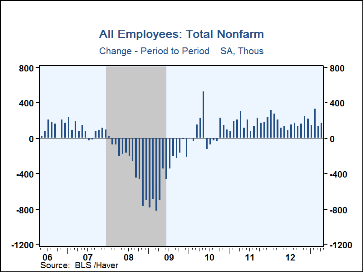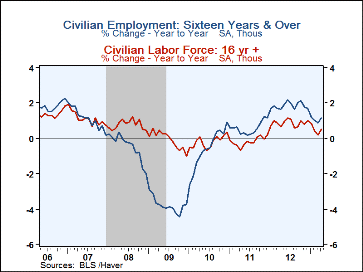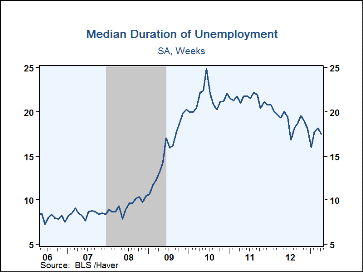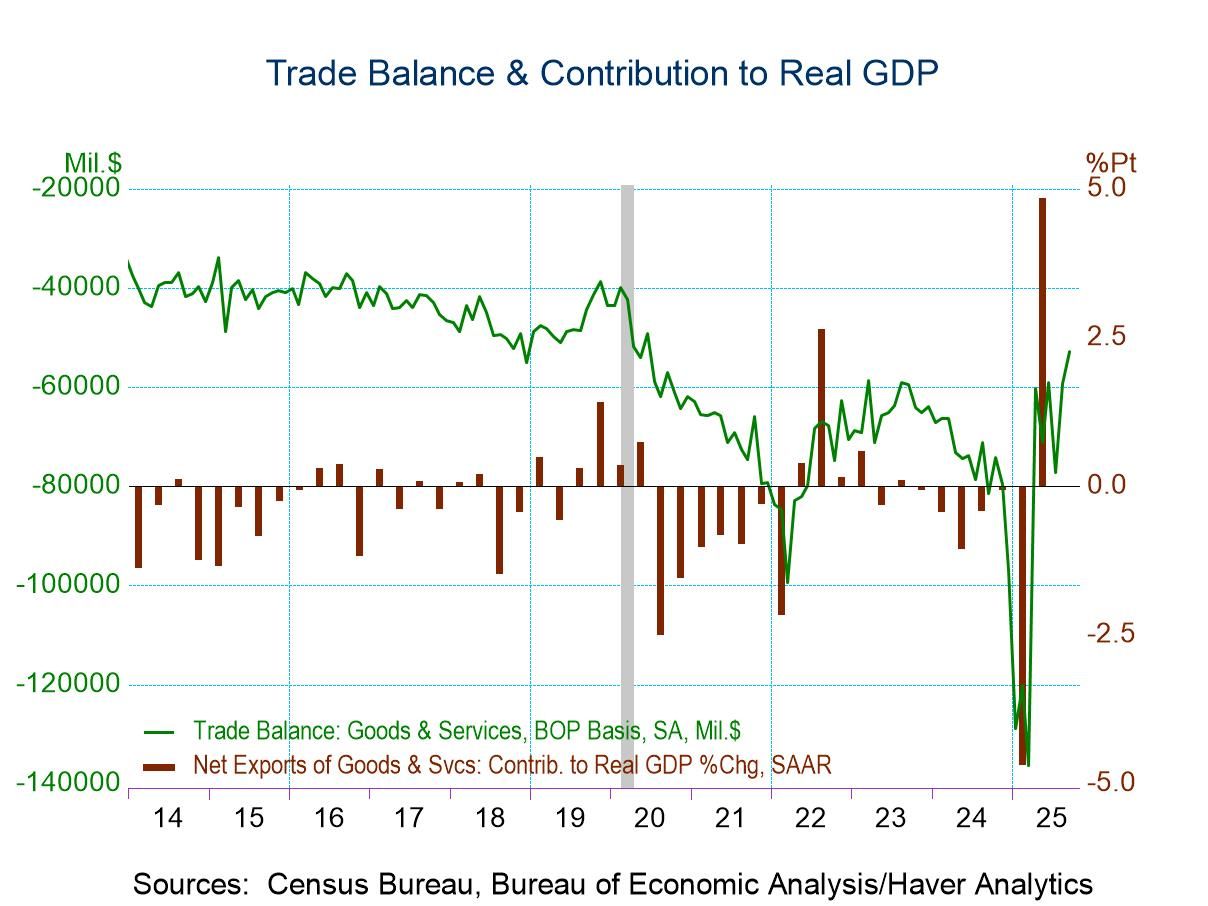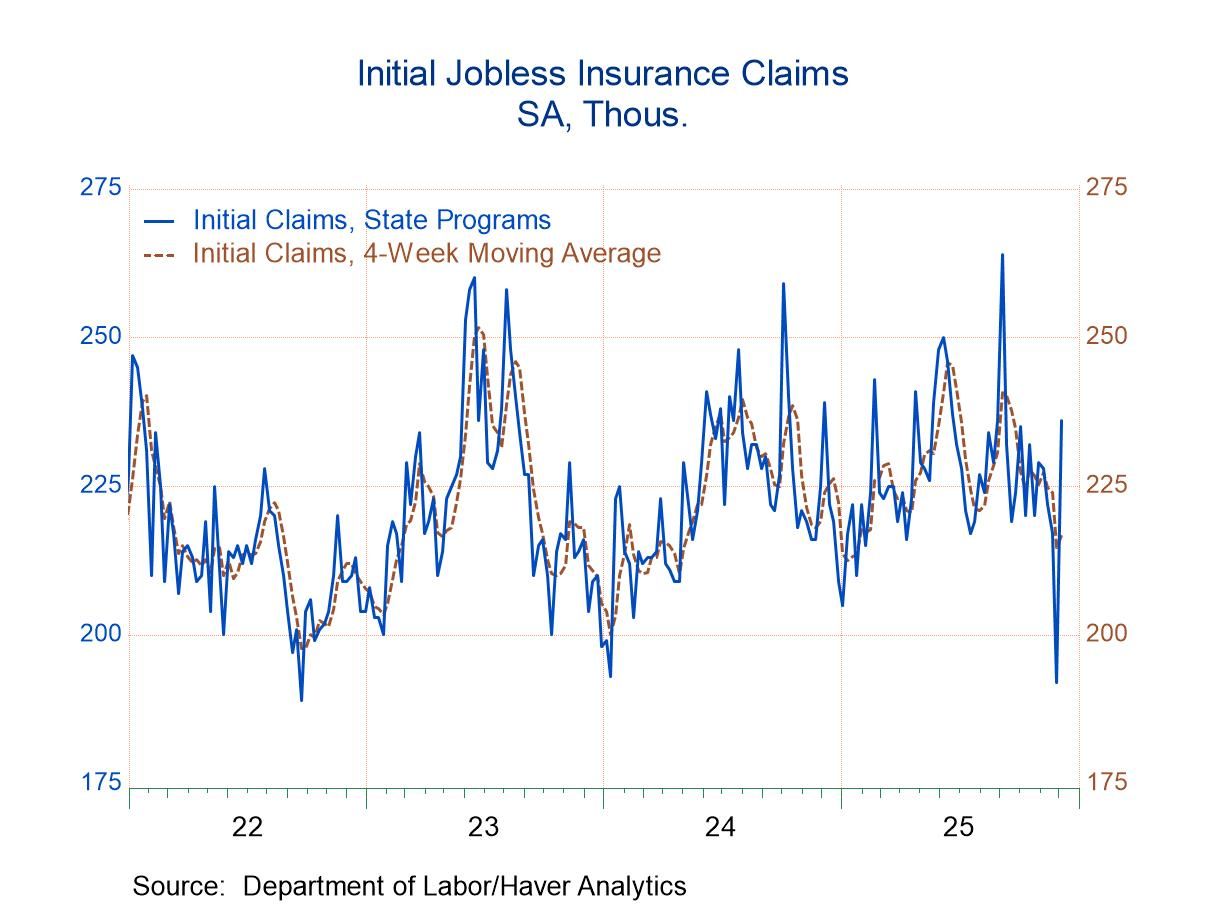 Global| May 03 2013
Global| May 03 2013U.S. Employment Growth Recovers; Jobless Rate Continues Lower
by:Tom Moeller
|in:Economy in Brief
Summary
The labor market rebounded somewhat last month following its March disappointment. Nonfarm payroll employment increased 165,000 (1.6% y/y) during April. That followed upwardly revised gains of 138,000 and 332,000 during the prior two [...]
The labor market rebounded somewhat last month following its March disappointment. Nonfarm payroll employment increased 165,000 (1.6% y/y) during April. That followed upwardly revised gains of 138,000 and 332,000 during the prior two months, earlier reported as 88,000 and 268,000, respectively. Consensus expectations were for a 160,000 increase. Improvement in the service sector led job growth last month. The unemployment rate fell during April to another cycle-low of 7.5%, the lowest since December 2008. A 7.6% rate had been expected. The jobless rate on the broadest measure of unemployment, which includes marginally attached & those involuntarily working part-time, ticked up m/m to 13.9%.
The jobs picture painted in the report on nonfarm payrolls showed mixed improvement. Growth was confined to the private service sector where payrolls increased 185,000 (2.1% y/y) following a 139,000 March gain. Professional & business service jobs rose 73,000 (3.3% y/y) while leisure & hospitality employment increased 43,000 (2.8% y/y). Jobs in trade, transportation & utilities improved by 37,000 (1.7% y/y). Employment in retail trade rose 29,300 (1.7% y/y) while health care jobs gained 26,100 (2.1% y/y). Financial activities employment rose 9,000 (1.3% y/y) but information sector hiring fell 9,000 (+0.4% y/y). In the factory sector, employment remained unchanged (0.6% y/y) while the number of construction jobs fell 6,000 (+2.7% y/y). Government sector jobs fell 11,000 (-0.4% y/y).
The mixed nature of last month's employment rise was highlighted by the diffusion index of one-month job change. At 53.9% it compared to a cycle-high of 72.2% in January of last year. In the factory sector, the index fell to a below break-even 44.4%. In addition, workers were on the job for a lessened 34.4 hours last month. In goods producing industries the workweek fell to 40.2 hours while in private services it fell to 33.3 hours.
Earnings growth has taken a hit as job increases have eased. The 0.1% uptick (1.7% y/y) in average hourly earnings followed no change during March. Goods producing earnings rose a steady 0.1% (1.3% y/y) while earnings in the private service sector also gained a stable 0.1% (1.8% y/y).
From household survey, the slip in the jobless rate to 7.5% reflected a 293,000 increase (1.2% y/y) in employment which made up March's decline. The labor force rose a lesser 210,000 (0.5% y/y) and that recovered just a third of the prior two months' contraction. The labor force participation rate was stable at 63.3% but remained down from its 67.1% high averaged from 1997 to 2000. The number of persons not in the labor force totaled 89.936 million (1.8% y/y). The number of discouraged workers fell 13.7% y/y. The median duration of unemployment fell to 17.5 months. The percentage of those unemployed who were out of work for more than one year rose m/m to 28.0% but that still was down from the 32.8% peak two years ago.
The figures referenced above are available in Haver's USECON database. Additional detail can be found in the LABOR and in the EMPL databases. The expectation figures are from Action Economics and are in the AS1REPNA database.
| Employment: (M/M Chg., 000s) | Apr | Mar | Feb | Y/Y | 2012 | 2011 | 2010 |
|---|---|---|---|---|---|---|---|
| Payroll Employment | 165 | 138 | 332 | 1.6% | 1.7% | 1.2% | -0.7% |
| Previous | -- | 88 | 268 | -- | 1.4 | 1.2 | -0.7 |
| Manufacturing | 0 | 2 | 23 | 0.6 | 1.7 | 1.7 | -2.7 |
| Construction | -6 | 13 | 48 | 2.7 | 2.0 | 0.3 | -8.3 |
| Private Service Producing | 185 | 139 | 244 | 2.1 | 2.2 | 1.9 | -0.1 |
| Government | -11 | -16 | 13 | -0.4 | -0.8 | -1.8 | -0.3 |
| Average Weekly Hours - Private Sector | 34.4 | 34.6 | 34.5 | 34.5 (Apr'12) |
34.4 | 34.4 | 34.1 |
| Average Private Sector Hourly Earnings (%) | 0.1 | 0.0 | 0.3 | 1.7 | 1.5 | 2.0 | 2.4 |
| Unemployment Rate (%) | 7.5 | 7.6 | 7.7 | 8.1 (Apr'12) |
8.1 | 8.9 | 9.6 |
Tom Moeller
AuthorMore in Author Profile »Prior to joining Haver Analytics in 2000, Mr. Moeller worked as the Economist at Chancellor Capital Management from 1985 to 1999. There, he developed comprehensive economic forecasts and interpreted economic data for equity and fixed income portfolio managers. Also at Chancellor, Mr. Moeller worked as an equity analyst and was responsible for researching and rating companies in the economically sensitive automobile and housing industries for investment in Chancellor’s equity portfolio. Prior to joining Chancellor, Mr. Moeller was an Economist at Citibank from 1979 to 1984. He also analyzed pricing behavior in the metals industry for the Council on Wage and Price Stability in Washington, D.C. In 1999, Mr. Moeller received the award for most accurate forecast from the Forecasters' Club of New York. From 1990 to 1992 he was President of the New York Association for Business Economists. Mr. Moeller earned an M.B.A. in Finance from Fordham University, where he graduated in 1987. He holds a Bachelor of Arts in Economics from George Washington University.


